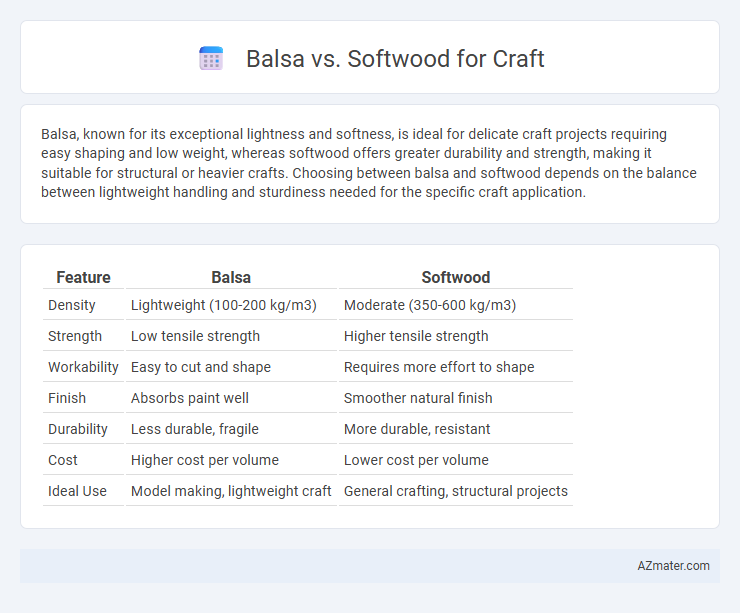Balsa, known for its exceptional lightness and softness, is ideal for delicate craft projects requiring easy shaping and low weight, whereas softwood offers greater durability and strength, making it suitable for structural or heavier crafts. Choosing between balsa and softwood depends on the balance between lightweight handling and sturdiness needed for the specific craft application.
Table of Comparison
| Feature | Balsa | Softwood |
|---|---|---|
| Density | Lightweight (100-200 kg/m3) | Moderate (350-600 kg/m3) |
| Strength | Low tensile strength | Higher tensile strength |
| Workability | Easy to cut and shape | Requires more effort to shape |
| Finish | Absorbs paint well | Smoother natural finish |
| Durability | Less durable, fragile | More durable, resistant |
| Cost | Higher cost per volume | Lower cost per volume |
| Ideal Use | Model making, lightweight craft | General crafting, structural projects |
Introduction: Balsa vs Softwood in Crafting
Balsa and softwood are both popular materials in crafting, each offering distinct advantages for various projects. Balsa is prized for its lightweight and easy-to-cut nature, making it ideal for model building and delicate crafts, while softwoods like pine and cedar provide greater strength and durability for structural or larger-scale creations. Understanding the specific properties of balsa versus softwood can help crafters select the best material to enhance their project's performance and aesthetic.
Material Overview: What is Balsa?
Balsa wood, known for its exceptionally low density and lightweight properties, is a fast-growing hardwood native to Central and South America. It features a soft, porous texture that makes it easy to cut, shape, and sand, ideal for delicate craft projects requiring precision and lightness. Unlike most softwoods, balsa's unique cellular structure provides high strength-to-weight ratio, making it a preferred choice for model building, aerodynamic designs, and lightweight crafts.
Understanding Softwood Types for Craft Projects
Softwood varieties like pine, cedar, and fir offer diverse textures and densities ideal for craft projects requiring durability and ease of shaping. Understanding the grain patterns and resin content in these softwoods helps crafters select the best material for carving, modeling, or woodworking tasks. Compared to balsa, which is prized for being lightweight and soft, softwoods provide more strength and structural integrity, making them suitable for crafts needing robust framework or fine detailing.
Weight Comparison: Balsa vs Softwood
Balsa wood is significantly lighter than most softwoods, making it ideal for lightweight craft projects that require easy handling and minimal weight. With a density ranging from 100 to 200 kg/m3, balsa is one of the lightest woods available, while common softwoods like pine and cedar have densities between 350 to 550 kg/m3. This weight difference affects the durability and structural strength in crafts, with softwoods generally providing more sturdiness but adding greater weight.
Strength and Durability: Performance Analysis
Balsa wood, known for its lightweight properties, offers moderate strength but lower durability compared to common softwoods such as pine or cedar, which provide enhanced structural integrity and resistance to wear. Softwoods generally exhibit higher density and better toughness, making them more suitable for crafts requiring long-lasting performance and resilience under stress. Choosing the right wood depends on the balance between balsa's ease of shaping and softwood's superior strength and durability in craft applications.
Workability: Cutting, Shaping, and Finishing
Balsa wood offers superior workability compared to most softwoods due to its lightweight, fine grain, and softness, allowing for effortless cutting, precise shaping, and smooth finishing. Softwoods like pine or cedar tend to be denser and may splinter or resist detailed carving, requiring sharper tools and more effort during the crafting process. The ease of working with balsa makes it ideal for intricate models and delicate craft projects where precision and a flawless finish are essential.
Cost and Availability: Which is More Affordable?
Balsa wood is generally more expensive than softwood due to its lightweight, fine grain, and limited regional availability, primarily sourced from Central and South America. Softwood varieties like pine or spruce are widely available globally, making them more affordable and accessible for craft projects. Cost efficiency in crafting depends on project requirements, but for budget-conscious crafters, softwood offers a more economical and readily available option compared to the premium pricing of balsa.
Applications: Ideal Uses for Balsa and Softwood
Balsa wood's lightweight and softness make it ideal for delicate craft projects such as model airplanes, architectural prototypes, and intricate sculptures where precision and easy carving are essential. Softwood varieties like pine and cedar excel in larger-scale crafts, outdoor decorations, and furniture making due to their durability, availability, and resistance to environmental factors. Selecting balsa for fine detail work and softwood for structural applications optimizes material performance and project outcomes.
Environmental Impact and Sustainability
Balsa wood offers a lower environmental impact due to its rapid growth rate, allowing for quicker carbon sequestration and sustainable harvesting compared to slower-growing softwoods like pine and spruce. Softwoods often come from managed forests with certifications such as FSC, ensuring responsible forestry practices but may have a larger ecological footprint due to longer growth cycles and higher energy inputs. Choosing balsa supports eco-friendly craft projects by minimizing deforestation and promoting renewable resources, while softwood selections require careful sourcing to balance durability and sustainability.
Conclusion: Choosing the Best Wood for Your Craft
Balsa wood offers exceptional lightweight properties and ease of carving, making it ideal for detailed, delicate craft projects where minimal weight is crucial. Softwood varieties such as pine or cedar provide greater durability and structural strength, better suited for larger or more functional craft pieces requiring resilience. Selecting the best wood for your craft depends on balancing the need for lightness versus sturdiness, with balsa favored for precision work and softwood preferred for robustness.

Infographic: Balsa vs Softwood for Craft
 azmater.com
azmater.com